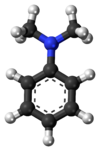Dimethylaniline
| |||
| Names | |||
|---|---|---|---|
| IUPAC name
N,N-Dimethylaniline
| |||
| Other names
DMA; Dimethylaminobenzene
| |||
| Identifiers | |||
3D model (JSmol)
|
|||
| ChEBI | |||
| ChEMBL | |||
| ChemSpider | |||
| ECHA InfoCard | 100.004.085 | ||
| KEGG | |||
PubChem CID
|
|||
CompTox Dashboard (EPA)
|
|||
| |||
| |||
| Properties | |||
| C8H11N | |||
| Molar mass | 121.183 g·mol−1 | ||
| Appearance | Colorless liquid | ||
| Density | 0.956 g/mL | ||
| Melting point | 2 °C (36 °F; 275 K) | ||
| Boiling point | 194 °C (381 °F; 467 K) | ||
| Hazards | |||
| Flash point | 63 °C (145 °F) | ||
Except where otherwise noted, data are given for materials in their standard state (at 25 °C [77 °F], 100 kPa).
| |||
N,N-Dimethylaniline (DMA) is an organic chemical compound, a substituted derivative of aniline. It consists of a tertiary amine, featuring dimethylamino group attached to a phenyl group. This oily liquid is colourless when pure, but commercial samples are often yellow. It is an important precursor to dyes such as Crystal violet.
Preparation and reactions
DMA was first reported in 1850 by A. W. Hofmann, who prepared it by heating aniline and iodomethane:[citation needed]
- C6H5NH2 + 2 CH3I → C6H5N(CH3)2 + 2 HI
DMA is produced industrially by alkylation of aniline with methanol in the presence of an acid catalyst:[1]
- C6H5NH2 + 2 CH3OH → C6H5N(CH3)2 + 2 H2O
Similarly, it is also prepared using dimethyl ether as the methylating agent.
Dimethylaniline undergoes many of the reactions expected for an aniline, being weakly basic and reactive toward electrophiles. For example, it is nitrated to produce tetryl, a derivative with four nitro groups which was once used as explosive. It is lithiated with butyllithium. Methylating agents attack the amine to give the quaternary ammonium salt:[2]
- C6H5N(CH3)2 + (CH3O)2SO2 → C6H5N(CH3)3CH3OSO3
Applications
DMA is a key precursor to commercially important triarylmethane dyes such as Malachite green and Crystal violet.[3] DMA serves as a promoter in the curing of polyester and vinyl ester resins.[4] DMA is also used as a precursor to other organic compounds.
References
- ^ Thomas Kahl, Kai-Wilfrid Schröder, F. R. Lawrence, W. J. Marshall, Hartmut Höke, Rudolf Jäckh "Aniline" in Ullmann's Encyclopedia of Industrial Chemistry 2007; John Wiley & Sons: New York.doi:10.1002/14356007.a02_303
- ^ J. Jacques and A. Marquet (1988). "Selective α-Bromination of an Aralkyl Ketone with Phenyltrimethylammonium Tribromide: 2-Bromoacetyl-6-methoxynaphthalene and 2,2-Dibromoacetyl-6-Methoxynaphthalene". Organic Syntheses; Collected Volumes, vol. 6, p. 175.
- ^ Thomas Gessner and Udo Mayer "Triarylmethane and Diarylmethane Dyes" in Ullmann's Encyclopedia of Industrial Chemistry 2002, Wiley-VCH, Weinheim.doi:10.1002/14356007.a27_179
- ^ General Info on DMA (N,N-Dimethylaniline), Composites Australia


